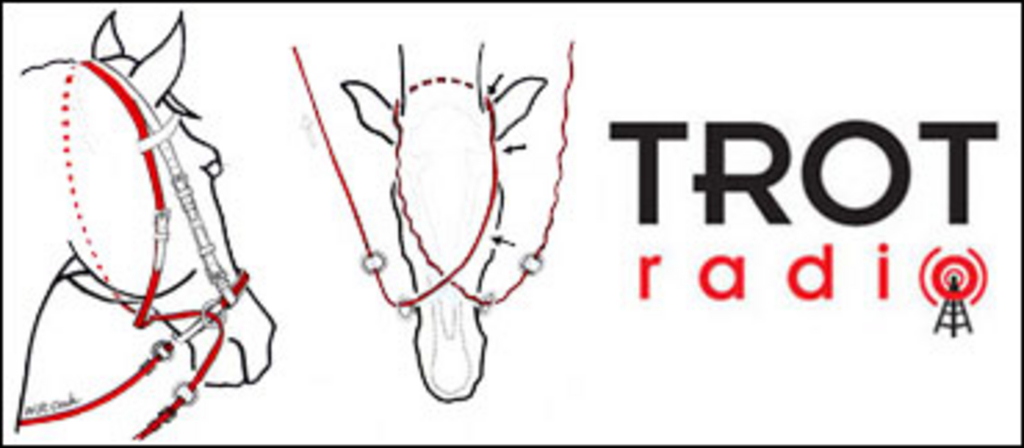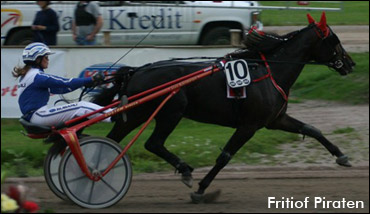
 In what developers call a "landmark advance in racehorse welfare", harness racing bodies in Sweden, Denmark, Finland and Norway approved the 'Harness Horse Bitless Bridle with bit bypass straps' for racing use
In what developers call a "landmark advance in racehorse welfare", harness racing bodies in Sweden, Denmark, Finland and Norway approved the 'Harness Horse Bitless Bridle with bit bypass straps' for racing use
in late October. If proof of success is needed, look no further.
On today's Trot Radio, Norm Borg revisits the concept of a bitless bridle with inventor Dr. Robert Cook, professor of surgery emeritus at the Cummings School of Veterinary Medicine at Tufts University in Grafton, Mass. Cook informed Trot Radio that the approval of his bitless bridle came after two years of collaboration between himself and a harness horse trainer in Sweden, Kerstin Kemlén.
 Fritiof Piraten, a three-year-old Andover Hall colt, raced with the bitless bridle at Sweden's Bollnas Racetrack on September 11, 2011. Normally this horse is what's referred to as a "hard puller" and frequently bleeds from the mouth. Because of a couple of false starts in a race three weeks prior, the horse had incurred a lacerated tongue that prevented further training in a standard bridle. At this stage, trainer Susanne Richter was introduced to the Harness Horse Bitless Bridle by Kemlén. After trailing the field, the horse produced an astonishing burst of speed in the last 400 meters. He finished a narrow second in the race and brought home 50,000 SEK or about $7,700.
Fritiof Piraten, a three-year-old Andover Hall colt, raced with the bitless bridle at Sweden's Bollnas Racetrack on September 11, 2011. Normally this horse is what's referred to as a "hard puller" and frequently bleeds from the mouth. Because of a couple of false starts in a race three weeks prior, the horse had incurred a lacerated tongue that prevented further training in a standard bridle. At this stage, trainer Susanne Richter was introduced to the Harness Horse Bitless Bridle by Kemlén. After trailing the field, the horse produced an astonishing burst of speed in the last 400 meters. He finished a narrow second in the race and brought home 50,000 SEK or about $7,700.
With six starts using this new bitless bridle, Fritiof Piraten has banked 135000 SEK in prize money or $20,000 and raced five of those six starts in the major Swedish trotting league while recording new personal bests for races 2140 meters and 2640 metres.
Will we see this bridle in use in North America? Cook doesn't see why trainers in Ontario couldn't start using it today.
"I spent half a hour looking over the standardbred rules of racing for the Ontario Racing Commission. Interestingly, I can't see anything in the rules of racing about equipment that is approved or unapproved."
To listen to the full interview with Dr. Cook and Borg, click the play button below.
Episode 237 – Dr. Robert Cook
Audio Format: MP3 audio
Host: Norm Borg
Please note that the opinions expressed in the featured interview are those of the participants and do not necessarily reflect Rideau Carleton Raceway and/or Standardbred Canada.


lynn i agree that simple is
lynn
i agree that simple is usually the best way to go, and a lot of gear is not needed and added anyways, i just felt that we should let it be know that sometimes the gear IS required, not always, but sometimes
Dr. Cook Do you have any
Dr. Cook
Do you have any photos of the CBB/bit, or could you describe how it differs from the standard CBB.
In reply to Dr. Cook Do you have any by kpmcbride
Kathy, The standard driving
Kathy,
The standard driving CBB does not have tunnels in the crown piece for an overcheck and, as I remember, does not have a throat latch. Blinders can be added with a loop fixture but open cheeks are an option.
Scott Martin When I see a
Scott Martin
When I see a horse go out onto the track with an overcheck, a tie-down,a headpole or two, blinders, shadow roles, earplugs, a tongue tie bits that scare the daylights out of me that are easily abused by the driver as they flap the reins and whip the horse, etc. etc., I wonder how the heck the horse can even function as well as it does. Do people even know the effect of some of this equipment? I know some don't but put it on anyway, needed or not. Scary. I'm from the old school where keeping it simple and the least amount of interference with the horse's natural way of going is often best for the welfare of the horse and for its performance.
lynn magee, I agree the race
lynn magee,
I agree the race horses are often way "over dressed" however, I do feel it is important for everyone to know, tongue ties are not used only as a means of stopping a horse form putting its tongue over the bit, but also to aid with minor respiratory ailments as well. A lot of the gear they wear on their heads and necks is to help steer.
A bitless bridal of any sort MAY help with steering problems, but certainly is not going to aleviate them all together. A lot of the over checks worn on the horses faces are to help keep them balanced and on gait, and to help with breathing issues etc. I do hope that in some cases, a bitless bridal will get rid of some of the gear, but i feel that it will not take its place all together.
In reply to lynn magee, I agree the race by scott martin
Lynn, your theoretical
Lynn, your theoretical assumption is correct. The CBB does away with the need for a tongue tie. Trainers may prefer to retain an overcheck but I recommend that this should be of the bitless variety. As Sandy found, many a horse that gets on a line and needs a head pole when bitted will run straight in the CBB. Improved steering is one of the first things that riders observe with the CBB and the same applies to driving.
Scott, I'm sorry but, as a veterinarian, I cannot agree that a tongue tie is a treatment for respiratory ailments. To treat a problem one has to remove the cause. The tongue tie is only perceived to be necessary because the bit is making the horse work its tongue. If you remove the bit (the cause), the tongue will bide quiet and the horse can breathe freely.
Wonderful! I recently
Wonderful!
I recently ordered a Kenny Edwards Controller for my standardbred mare. Abigail has been with me since she was a yearling as a riding horse and she has never had a bit in her mouth (12 years). I wanted to start teaching her to drive and did not consider a bitted bridle as an option. It just didn't seem fair. (Hey, girl. I'm going to teach you something new, so I'm going to put this cold metal object in your mouth.) I'm really happy to see this as an alternative. I am not against bits, as my other retired Standie is nicknamed "The Brat" and will do her best to disobey if I try anything without a bit. Hazel is ridden and driven, drops her head and opens her mouth willingly. I recently rode her in a hackamore and she tried to put that in her mouth!
Any news about new innovations is good news!
Dr. Robert Cook-any information on where I could purchase this bridle would be most appreciated. Thank you.
Sandy, your comments are
Sandy, your comments are most interesting. I would very much like to learn more about the bitless equipment that has been used in the past and with which you are familiar.
But before this thread progresses, which I hope it will, may I suggest some terminology that will allow everyone to clearly understand what specific type of bitless bridle is being referred to by each contributor.
The term 'bitless bridle' is a generic term that includes the sub-section generic terms of:
hackamore (various sorts),
sidepull (with different types of noseband),
rope halters (narrow or thick),
and crossunder bitless bridles (several proprietary names).
It will avoid misunderstandings if we are specific about which bitless bridle it is to which we refer, yet without using proprietary names.
The generic term 'crossunder bitless bridle' is something of a handful to type, so I suggest the acronym CBB. If the CBB is being referred to in conjunction with a bit and a bit bypass strap, I suggest the generic term, CBB/bit.
Bob
The bitless bridle or a
The bitless bridle or a variation of it is not a new thing.
The late Eddie Bradette used one in Sudbury in the mid seventies and it didn't look brand new then.
Over my long and undistinguised career I trained many and raced a few with it.
I found it most benificial on horses with the classic bit sore from riding a line for a long period of time. It gave the mouth time to heal.
I used it with success on a mare who as soon as you tightened the line in her mouth behind the gate would throw her head and run. The trainer Barry Armstrong was game to try it and we had alot of success with it.
I also had a colt of our own who would get on a line so bad from fighting the bit that you thought he was going to fall over the hub rail. Strangley enough he drove straight with the bitless bridle and you could leave hard, take back, or fit/sit him in a hole no problem.
A foul gaited horse was another story, I alway felt with a misstep you could end up on your head.
The bitless bridle is not the be all end all, but I believe it is a tool that has its place.
Sandy Best
I live in the USA and have
I live in the USA and have been using a bitless bridle for years. I am hoping they approve bitless bridle for USA!! AWESOME!! You really won't believe the control you have, also the horse is really relaxed!
In reply to I live in the USA and have by twinfox
Theoretically, one should be
Theoretically, one should be able to do away with the tongue-tie when using a bitless bridle. How about all of the other crap that goes on a standardbred's head and neck? If they are started in one of these bridles, the driver should have no problem with controlling steering, imo. Even changing them from a traditional bitted bridle should give them so much relief in the mouth, I would think that they would respond positively. Thank you Dr. Cook.